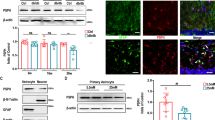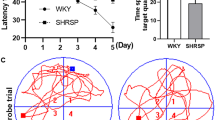Abstract
Patients with diabetes mellitus are easy to experience diabetic encephalopathy (DE) and other cognition dysfunction, whereas the neural alterations in developing this disease are unknown yet. Chrysophanol (CHR) is one of traditional Chinese medicine which was reported to show protective effects in cognition dysfunction and inflammatory in previously studies. In this current study, whether CHR protects learning and memory dysfunctions induced by diabetes disease or not and underlying mechanisms were studied. DE model was induced by streptozotocin (STZ, i.p.) in ICR mice. CHR was administrated 3 days after STZ treated mice which was confirmed with diabetes for consecutive 6 days. Learning and memory function was tested by Morris water maze after the CHR injection. The morphology of neuronal cells in hippocampus CA3 region was stained by HE-staining. ELISA and Western blot assay were used to determine the levels of pro-inflammation cytokines (IL-1β, IL-4, IL-6, TNF-α) in hippocampus. Here, we demonstrated that mice harboring diabetes mellitus induced by STZ exhibit high blood glucose, learning and memory deficits detected by Morris water maze behavior tests. Application with CHR right after developing diabetes disease rescues partial blood sugar increasing, learning and memory deficits. The data also indicated that the death rate of neurons and the number of astrocytes in hippocampus CA3 region was significantly improved in diabetic mice. Moreover, the underlying mechanisms of CHR’s protective effect are likely associated with anti-inflammation by downregulating the expression of pro-inflammation cytokines (IL-1β, IL-4, IL-6, TNF-α) in hippocampus and inhibiting the over-activation of astrocytes in hippocampus CA3 region. Therefore, application with CHR contributes to the learning and memory deficits induced by diabetes disease via inhibitory expressions of inflammatory in hippocampus region.






Similar content being viewed by others
Abbreviations
- DE:
-
Diabetic encephalopathy
- CHR:
-
Chrysophanol
- STZ:
-
Streptozotocin
- AD:
-
Alzheimer disease
- IL:
-
Interleukin
- TNF-α:
-
Tumor necrosis factor
- CA3:
-
Cornu ammonis
- MWM:
-
Morris water maze
References
McCrimmon RJ, Ryan CM, Frier BM (2012) Diabetes and cognitive dysfunction. Lancet 379:2291–2299
Sima AA, Kamiya H, Li ZG (2004) Insulin, C-peptide, hyperglycemia, and central nervous system complications in diabetes. Eur J Pharmacol 490:187–197
Biessels GJ, Deary IJ, Ryan CM (2008) Cognition and diabetes: a lifespan perspective. Lancet Neurol 7:184–190
Arvanitakis Z, Wilson RS, Bienias JL, Evans DA, Bennett DA (2004) Diabetes mellitus and risk of Alzheimer disease and decline in cognitive function. Arch Neurol 61:661–666
Lin F, Zhang C, Chen X, Song E, Sun S, Chen M, Pan T, Deng X (2015) Chrysophanol affords neuroprotection against microglial activation and free radical-mediated oxidative damage in BV2 murine microglia. Int J Clin Exp Med 8:3447–3455
Zhang J, Yan C, Wang S, Hou Y, Xue G, Zhang L (2014) Chrysophanol attenuates lead exposure-induced injury to hippocampal neurons in neonatal mice. Neural Regeneration Res 9:924–930
Shen CY, Jiang JG, Yang L, Wang DW, Zhu W (2017) Anti-ageing active ingredients from herbs and nutraceuticals used in traditional Chinese medicine: pharmacological mechanisms and implications for drug discovery. Br J Pharmacol 174:1395–1425
Wirt RA, Hyman JM (2017) Integrating spatial working memory and remote memory: interactions between the medial prefrontal cortex and hippocampus. Brain Sci 7: 43
Kim SJ, Kim MC, Lee BJ, Park DH, Hong SH, Um JY (2010) Anti-Inflammatory activity of chrysophanol through the suppression of NF-kappaB/caspase-1 activation in vitro and in vivo. Molecules 15:6436–6451
van Horssen R, Ten Hagen TL, Eggermont AM (2006) TNF-alpha in cancer treatment: molecular insights, antitumor effects, and clinical utility. Oncol 11:397–408
Fisman EZ, Adler Y, Tenenbaum A (2008) Biomarkers in cardiovascular diabetology: interleukins and matrixins. Adv Cardiol 45:44–64
Arranz L, Arriero MDM, Villatoro A (2017) Interleukin-1beta as emerging therapeutic target in hematological malignancies and potentially in their complications. Blood Rev 31(5):306–317
Su H, Lei CT, Zhang C (2017) Interleukin-6 signaling pathway and its role in kidney disease: an update. Front Immunol 8:405
Matsunaga MC, Yamauchi PS (2016) IL-4 and IL-13 inhibition in atopic dermatitis. J Drugs Dermatol 15:925–929
Nagayach A, Patro N, Patro I (2014) Astrocytic and microglial response in experimentally induced diabetic rat brain. Metab Brain Dis 29:747–761
Tripathi DN, Jena GB (2008) Astaxanthin inhibits cytotoxic and genotoxic effects of cyclophosphamide in mice germ cells. Toxicology 248:96–103
Morris RG, Garrud P, Rawlins JN, O’Keefe J (1982) Place navigation impaired in rats with hippocampal lesions. Nature 297:681–683
Zamzow DR, Elias V, Legette LL, Choi J, Stevens JF, Magnusson KR (2014) Xanthohumol improved cognitive flexibility in young mice. Behav Brain Res 275:1–10
Larsen JO, Gundersen HJ, Nielsen J (1998) Global spatial sampling with isotropic virtual planes: estimators of length density and total length in thick, arbitrarily orientated sections. J Microsc 191:238–248
West MJ, Gundersen HJ (1990) Unbiased stereological estimation of the number of neurons in the human hippocampus. J Comp Neurol 296:1–22
Wang M, Yan W, Liu Y, Hu H, Sun Q, Chen X, Zang W, Chen L (2017) Erythropoietin ameliorates diabetes-associated cognitive dysfunction in vitro and in vivo. Sci Rep 7:2801
Becerra-Calixto A, Cardona-Gomez GP (2017) The role of astrocytes in neuroprotection after brain stroke: potential in cell therapy. Front Mol Neurosci 10:88
Wang B, Miao Y, Zhao Z, Zhong Y (2015) Inflammatory macrophages promotes development of diabetic encephalopathy. Cell Physiol Biochem 36:1142–1150
Rostami S, Momeni Z, Behnam-Rassouli M, Rooholamin S (2013) A comparative study on the effects of type I and type II diabetes on learning and memory deficit and hippocampal neuronal loss in rat. Minerva Endocrinol 38:289–295
Greenberg A, Whitten TA, Dickson CT (2016) Stimulating forebrain communications: slow sinusoidal electric fields over frontal cortices dynamically modulate hippocampal activity and cortico-hippocampal interplay during slow-wave states. NeuroImage 133:189–206
Rebola N, Carta M, Mulle C (2017) Operation and plasticity of hippocampal CA3 circuits: implications for memory encoding. Nat Rev Neurosci 18:208–220
Yin Z, Yu H, Chen S, Ma C, Ma X, Xu L, Ma Z, Qu R, Ma S (2015) Asiaticoside attenuates diabetes-induced cognition deficits by regulating PI3K/Akt/NF-kappaB pathway. Behav Brain Res 292:288–299
He Y, Wang F, Chen S, Liu M, Pan W, Li X (2015) The protective effect of radix polygoni multiflori on diabetic encephalopathy via regulating myosin light chain kinase expression. J Diab Res 2015:484721
Pei B, Sun J (2018) Pinocembrin alleviates cognition deficits by inhibiting inflammation in diabetic mice. J Neuroimmunol 314:42–49
Oliveira WH, Nunes AK, Franca ME, Santos LA, Los DB, Rocha SW, Barbosa KP, Rodrigues GB, Peixoto CA (2016) Effects of metformin on inflammation and short-term memory in streptozotocin-induced diabetic mice. Brain Res 1644:149–160
Fakhoury M (2017) Microglia and astrocytes in Alzheimer’s disease: implications for therapy. Curr Neuropharmacol. https://doi.org/10.2174/1570159X15666170720095240
Li D, Liu L, Li L, Li X, Huang B, Zhou C, Zhang Z, Wang C, Dong P, Zhang X, Yang B, Zhang L (2017) Sevoflurane induces exaggerated and persistent cognitive decline in a type II diabetic rat model by aggregating hippocampal inflammation. Front Pharmacol 8:886
Chae U, Min JS, Lee H, Song KS, Lee HS, Lee HJ, Lee SR, Lee DS (2017) Chrysophanol suppresses pro-inflammatory response in microglia via regulation of Drp1-dependent mitochondrial fission. Immunopharmacol Immunotoxicol 39:268–275
Bhat T, Teli S, Rijal J, Bhat H, Raza M, Khoueiry G, Meghani M, Akhtar M, Costantino T (2013) Neutrophil to lymphocyte ratio and cardiovascular diseases: a review. Exp Rev Cardiovasc Ther 11:55–59
Stegenga ME, van der Crabben SN, Blumer RM, Levi M, Meijers JC, Serlie MJ, Tanck MW, Sauerwein HP, van der Poll T (2008) Hyperglycemia enhances coagulation and reduces neutrophil degranulation, whereas hyperinsulinemia inhibits fibrinolysis during human endotoxemia. Blood 112:82–89
Shiny A, Bibin YS, Shanthirani CS, Regin BS, Anjana RM, Balasubramanyam M, Jebarani S, Mohan V (2014) Association of neutrophil-lymphocyte ratio with glucose intolerance: an indicator of systemic inflammation in patients with type 2 diabetes. Diab Technol Ther 16:524–530
Tsai JC, Sheu SH, Chiu HC, Chung FM, Chang DM, Chen MP, Shin SJ, Lee YJ (2007) Association of peripheral total and differential leukocyte counts with metabolic syndrome and risk of ischemic cardiovascular diseases in patients with type 2 diabetes mellitus. Diab Metab Res Rev 23:111–118
Sefil F, Ulutas KT, Dokuyucu R, Sumbul AT, Yengil E, Yagiz AE, Yula E, Ustun I, Gokce C (2014) Investigation of neutrophil lymphocyte ratio and blood glucose regulation in patients with type 2 diabetes mellitus. J Int Med Res 42:581–588
Li YB, Zhang WH, Liu HD, Liu Z, Ma SP (2016) Protective effects of Huanglian Wendan Decoction aganist cognitive deficits and neuronal damages in rats with diabetic encephalopathy by inhibiting the release of inflammatory cytokines and repairing insulin signaling pathway in hippocampus. Chin J Nat Med 14:813–822
Lee MS, Sohn CB (2008) Anti-diabetic properties of chrysophanol and its glucoside from rhubarb rhizome. Biol Pharm Bull 31:2154–2157
Hamed SA (2017) Brain injury with diabetes mellitus: evidence, mechanisms and treatment implications. Exp Rev Clin Pharmacol 10:409–428
Bashier A, Khalifa AA, Rashid F, Abdelgadir EI, Al Qaysi AA, Ali R, Eltinay A, Nafach J, Alsayyah F, Alawadi F (2017) Efficacy and safety of SGLT2 inhibitors in reducing glycated hemoglobin and weight in emirati patients with type 2 diabetes. J Clin Med Res 9:499–507
Fadini GP, Bonora BM, Avogaro A (2017) SGLT2 inhibitors and diabetic ketoacidosis: data from the FDA adverse event reporting system. Diabetologia 60(8):1385–1389
Izaguirre M, Gil MJ, Monreal I, Montecucco F, Fruhbeck G, Catalan V (2017) The role and potential therapeutic implications of the fibroblast growth factors in energy balance and type 2 diabetes. Curr Diab Rep 17:43
Lee S, Lee DY (2017) Glucagon-like peptide-1 and glucagon-like peptide-1 receptor agonists in the treatment of type 2 diabetes. Ann Pediatr Endocrinol Metab 22:15–26
Li P, Lu Q, Jiang W, Pei X, Sun Y, Hao H, Hao K (2017) Pharmacokinetics and pharmacodynamics of rhubarb anthraquinones extract in normal and disease rats. Biomed Pharmacother 91:425–435
Zou W, Yuan J, Tang ZJ, Wei HJ, Zhu WW, Zhang P, Gu HF, Wang CY, Tang XQ (2017) Hydrogen sulfide ameliorates cognitive dysfunction in streptozotocin-induced diabetic rats: involving suppression in hippocampal endoplasmic reticulum stress. Oncotarget 8:64203–64216
Acknowledgements
This work was supported by Science and Technology development Plan of Jining city (JKZ[2015]57-94).
Author information
Authors and Affiliations
Contributions
QK designed the study. XC, SZ, RS, LW, and CX performed the experiments and collected the data. XC, SZ, and RS analyzed and interpreted the experimental data. XC and CX prepared the manuscript.
Corresponding author
Ethics declarations
Conflict of interest
The authors declare no competing financial interests.
Rights and permissions
About this article
Cite this article
Chu, X., Zhou, S., Sun, R. et al. Chrysophanol Relieves Cognition Deficits and Neuronal Loss Through Inhibition of Inflammation in Diabetic Mice. Neurochem Res 43, 972–983 (2018). https://doi.org/10.1007/s11064-018-2503-1
Received:
Revised:
Accepted:
Published:
Issue Date:
DOI: https://doi.org/10.1007/s11064-018-2503-1




